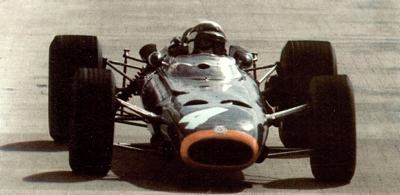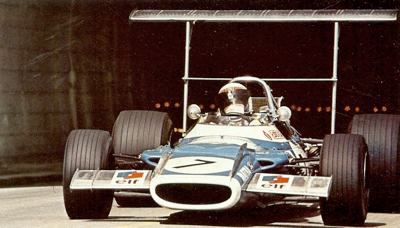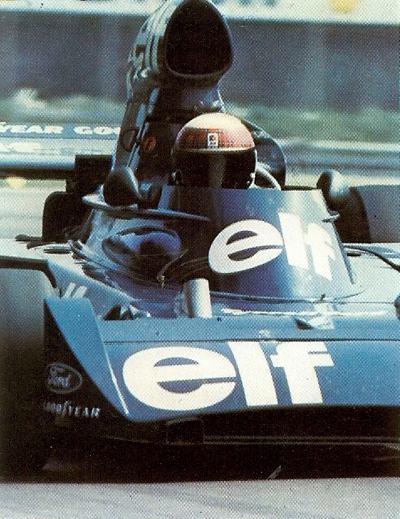John Young Stewart
Born on the 11th June 1939, John Young Stewart - always known as Jackie - was the son of a garage proprietor, Robert Stewart, who once raced motor cycles as an amateur. The boy was introduced to motor racing by his brother Jimmy, eight years his senior, who was an accomplished sports car driver.
Jimmy raced for the Ecurie Ecosse Jaguar team and the works Aston Martin team until a serious crash at
Le Mans in 1954 ended a promising career. That same year 15-year-old Jackie left Dumbarton Academy, where he excelled at sports, and joined the family Dumbuck Garage as a petrol attendant. Later he switched to the mechanical side of the business and joined his father and brother as a partner.
It was probably inevitable that Jackie would want to follow his brother into motor racing, but following Jimmy's fearful accident family permission was not all that easy to obtain. Instead he turned his attention to clay pigeon shooting, becoming a member of the British team in 1959. The following year he narrowly missed selection for the Olympic team and in 1964 would have been included but for his motor racing.
Barry Filer
In 1960 Glasgow enthusiast Barry Filer, for whom the Stewarts' garage prepared a stable of racing machinery for he and his friends to drive, offered Jackie the chance to race at a club meeting at Charterhall; Scotland's only circuit at that time. He declined, worried about his mother's reaction, but instead, with the approval of his father and brother, went down to Oulton Park in Cheshire (UK) to test Filer's Porsche Super 90. Stewart competed in a sprint and looked forward to a season of racing in 1961.
Filer bought a Ford-engined Marcos GT, an ugly, wooden machine, but very effective in Stewart's hands in four local races. He once raced Filer's Aston Martin DB4GT. Early in 1962 he wanted to decide whether or not to go racing seriously and with a party of friends - including well-known motor cycle racer Bob McIntyre - went to Oulton Park to test Filer's Aston and AC Ace-Bristol plus the Jaguar E-type demonstrator from the family garage. Stewart's times in the
E-type were comparable to Roy Salvadori's in a similar car the previous year and he decided there and then to pursue his new interest further.
Helen McGregor
In August he married Helen McGregor, his sweetheart for five years, and the write-up in the local newspaper gave his racing game away. His mother now knew, but received the news more calmly than anticipated. In 1963 Stewart raced in England for the first time, venturing to Yorkshire's Rufforth airfield circuit on Easter Saturday where he won two races in the Jaguar. His excellent performances won him further drives in friends' Jaguars and ultimately David Murray of Ecurie Ecosse allowed Stewart to drive one of the difficult Buick-engined Tojeiro EE Mk 2s at Charterhall. Stewart won and was later offered the wheel of the team's Cooper T 49 Monaco-Climax, winning impressively at Goodwood in Sussex.
Stewart was also a member of the winning team in the Five-Hour Relay Race at Oulton Park, driving a Jaguar 3.8, and at the end of the year his score was 14 wins, one second, two thirds and six retirements from 23 starts. Autosport hailed him as the leading club driver of the year, while he also won the Chris Bristow and Ron Flockhart Memorial Trophies. The 1964 season saw Stewart's career snowball. He signed with Ecurie Ecosse to drive their old Cooper and a Ford-engined Tojeiro EE Mk 3 in sports car races and with Charles Bridges to race a Lotus Ford Cortina in saloon car events.
Tyrrell's Formula Three Cooper T72-BMCs
But these drives were to pale into insignificance as the months went by - Goodwood's track manager Robin McKay, in conversation with Ken Tyrrell, suggested Stewart's name as a driver for Tyrrell's team of Formula Three Cooper T72-BMCs. McKay had watched Stewart at Goodwood the previous year and had been very impressed. The outcome was that Tyrrell invited Stewart to test the new car at Goodwood and quickly signed him up when Jackie lapped quicker than Formula One driver Bruce McLaren. His first race was at Norfolk's Snetterton circuit on 15 March in torrential rain.
 Jackie Stewart in action during the 1967 Formula One season in his BRM, at the Monaco GP.
Jackie Stewart in action during the 1967 Formula One season in his BRM, at the Monaco GP.
 Jackie Stewart and the Matra MS80 at Monaco in 1969.
Jackie Stewart and the Matra MS80 at Monaco in 1969.
 Jackie Stewart driving Tyrrell 006 on his way to winning the World Championship in 1973; this was a high note on which he would retire.
Jackie Stewart driving Tyrrell 006 on his way to winning the World Championship in 1973; this was a high note on which he would retire. |
After one lap Stewart led by 11 seconds; next time round he was 25 seconds ahead; by the time the 10 laps were over Stewart had eased up to canter home with a 44 second advantage over the second finisher. Stewart had arrived and within days was offered a Formula One drive by Cooper. He declined, preferring to gain more experience. Stewart went on to win the Express C5 Star Formula Three Championship, failing to win only two races with the Tyrrell Cooper. Once his clutch failed and once he spun. He was invited to race Ron Walker's Lotus Elan, proving quicker than the works drivers, handled John Coombs' lightweight
Jaguar E-type and by June was reserve driver for the Maranello Concessionaires' Ferrari team at Le Mans; he practised but did not race.
During unofficial practice for the European
Grand Prix at Brands Hatch (where Stewart was competing in all three supporting races) he was suddenly offered a trial in a Formula One Lotus 33-Climax. He accepted and impressed
Colin Chapman of
Lotus and fellow Scot
Jim Clark, the reigning World Champion, with his cool but quick driving. But he considered himself still not ready for Formula One and turned down an offer from
Lotus. He did, however, race for the Lotus Formula Two and saloon car teams before the season was over.
Stewart's first time out in Formula Two he was second at the difficult Clermont-Ferrand circuit in a Lotus 32-Cosworth, and in a Lotus-Ford Cortina he won the Marlboro 12-hours in the US. Turning down offers from Lotus and Cooper, Stewart signed to race alongside
Graham Hill in the works
BRM Formula One team in 1965. But in December 1964 he had his first official Formula One race in
Jim Clark's Lotus. Clark had injured his back in a non-racing incident and was unable to take part in the non-championship Rand
Grand Prix in South Africa. Stewart deputised. He broke both drive-shafts starting the first heat, but won the second.
The 1965 South African Grand Prix
In his first World Championship race, the South African
Grand Prix of 1965, Stewart drove sensibly into sixth place. He impressed the Formula One 'circus' with his ability. As the season progressed he very quickly learned the art of
Grand Prix racing and adapted to tough circuits such as Francorchamps and
Nurburgring with ease. He won the non-championship Daily Express Trophy race at Silverstone in May and the Italian
Grand Prix at Monza in September after a wheel-to-wheel battle with
Graham Hill's similar 1
½-litre
BRM P261. With three seconds, a third, a fifth and a sixth to add to these wins Stewart was third in the World Championship.
Next was a quieter year for Stewart: whereas he had started 53 races in 1964 the total was much lower in 1965. He concentrated on Formula One but also handled Ken Tyrrell's unsuccessful Formula Two Cooper T75-
BRM, was
10 th in the Le Mans 24-hours in the gas turbine Rover-
BRM, and in a Team Surtees Lola T70 Mk 1-Chevrolet sports car he finished third in the Guards Trophy at Brands Hatch. For 1966
BRM built the H16-engined P83 for the new 3-litre Formula One, but the machine proved a disaster. Stewart preferred to use a 2.1-litre V8 engine in an older P261 chassis and began the season well with victory in the
Tasman Cup Series and the Monaco Grand Prix.
Stewart almost won the Indianapolis 500 at his first attempt, the engine of his John Mecom entered Lola T90-Ford expiring with only 20 miles to run. A few days later Stewart's career almost ended in the Belgian Grand Prix. On the opening lap his
BRM P261 spun wildly in pouring rain at the Francorchamps circuit and plunged off the road. Stewart was trapped in the overturned car and was rescued, soaked in petrol, by fellow drivers
Graham Hill and Bob Bondurant, who had also crashed nearby. Stewart suffered a broken shoulder, a cracked rib and internal bruising, but was back in racing two months later. The BRMs were, however, outclassed and no further wins came his way.
The Rothmans 12 hour at Surfers
Stewart remained with the Tyrrell team in Formula Two, beginning an association with the French marque
Matra, but no wins came his way. During a visit to Australia in August, however, Stewart co-drove a Ferrari 250LM to victory in the Rothmans 12-hour sports' car race at Surfers Paradise. So far as Formula One was concerned, 1967 was a disastrous season for Stewart, best result being second in the Belgian
Grand Prix in an H16
BRM P83. Driving Matra MS5s and MS7s for Tyrrell, however, Stewart enjoyed some success in Formula Two, winning at Karlskoga, Enna, Oulton Park and Albi.
Driving his one and only race for Ferrari, he was second in the
BOAC 500 sports car race at Brands Hatch in a 4-litre 330P shared with
Chris Amon. It came as no surprise when Stewart quit
BRM. He almost joined Ferrari for 1968 but didn't like the Italian politics. Jackie gambled instead on a newcomer to Formula One, none other than Ken Tyrrell. Tyrrell arranged to instal the Ford DFV engine in a chassis built by Matra, the MS10. It was not a brilliant car, but a combination of Stewart's exceptional driving and ever-improving
tyres from Dunlop enabled Jackie to win the Dutch
Grand Prix (in torrential rain), the
German Grand Prix (in fog) and the United States Grand Prix.
These wins put Stewart in contention for the World Championship, despite the fact in April he cracked his wrist in a Formula Two practice accident at Jarama in Spain. This prevented participation in the Spanish and Monaco Grands Prix plus the Indianapolis 500 and meant that Stewart had to race with a plastic 'sleeve'. In the final round of the championship in Mexico his engine let him down and the title went to his mentor,
Graham Hill. By now the Stewart family was installed in Switzerland, a move precipitated by Stewart's busy schedule as much as financial reasons. Jackie made amends in 1969. He won his first World Championship following wins in the South African, Spanish, Dutch, French, British and Italian Grands Prix, also the Daily Mail Race of Champions at Brands Hatch, all but the first victory being achieved in Matra's new Ford-engined MS80.
In Formula Two Stewart won at
Nurburgring and Jarama to crown his best year to date. For 1970, however, Chrysler's takeover of
Matra dictated the end of Ford engines for the French cars. Stewart tested a car with Matra's own V12 engine but insisted on Ford power for 1970. Tyrrell gambled on a design from a completely new manufacturer, March. It transpired that the conventionally-designed March 701-Ford was sufficient to give Stewart victory in the Daily Mail Race of Champions and the Spanish Grand Prix, but thereafter it was outclassed by the Lotus 72.
The Tyrrell 003-Ford
In August, however, Tyrrell unveiled one of motor racing's best-kept secrets, his own Tyrrell 001-Ford Formula One car. It was plagued by niggling problems which kept it from finishing but showed sufficient promise for Stewart to look forward to the 1971 season. Sure enough, the Tyrrell Formula One car lived up to its promise. In 1971 Stewart won the Spanish, Monaco, French, British, German and Canadian Grands Prix to be acclaimed as World Champion for the second time. All his victories were in the same car, Tyrrell 003-Ford, a car presented to him on his retirement.
Lured by the large prize funds, Stewart attempted a full season, in Can-Am with a Lola T260-Chevrolet following an outing in the Chaparral 2J 'vacuum cleaner' the previous season. Although the car was uncompetitive compared with the all-conquering McLarens, Stewart won two rounds: St Jovite and Mid-Ohio. In 1972, Stewart was handicapped by illness, a gastric ulcer preventing his participation in the Belgian
Grand Prix and handicapping his performances in earlier events. Nevertheless, he fought back strongly to win the French, Canadian and United States Grands Prix which, added to his win in Argentina in January, placed him second to
Emerson Fittipaldi in the World Championship.
Order of the British Empire
His illness also meant the cancellation of plans to drive a works McLaren in the Can-Am series, but he raced a
Ford Capri RS2600 in the Paul Ricard 6-hour touring car race and finished second. Stewart was awarded the Order of the British Empire in 1972. On 5 April, 1973, Jackie Stewart came to a decision. He was to retire from motor racing at the end of the year. He confided in three close friends, but kept the news from journalists and his family until he had competed in his last race. Fittingly, Stewart gained his third World Championship that year after wins in South Africa, Belgium, Monaco, Holland, Germany and Austria. His last race was to have been the United States Grand Prix, co-incidentally his 100th Grand Prix, but he withdrew following the fatal accident to his team-mate and good friend Francois Cevert in practice. It was a sad note upon which to retire.
After his retirement Stewart was active on the promotional front, commentating on TV and radio, and coaching his successors in the Tyrrell team. Despite his avowal to make a clean break from racing, Stewart did carry out a series of test drives on the Formula One cars of 1978 for Autocar at the Paul Ricard circuit in France. He appeared to be as fast as ever, and was prompted to say that little, save the Lotus, had changed since his day. He has also been seen at the wheel of a camera-equipped Formula One car at various circuits, giving viewers a driver's-eye view of
Grand Prix racing. Stewart held the record for most wins by a Formula One driver (27) for 14 years (broken by Alain Prost in 1987) and the record for most wins by a British Formula One driver for 19 years (broken by
Nigel Mansell in 1992).



